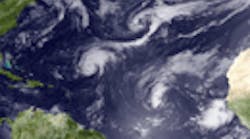The first storm of the Atlantic hurricane season, the powerful Category 4 Earl is churning its way toward the East Coast, where it is expected to first slam into North Carolina’s Outer banks barrier islands. From there, Earl is currently expected to track north-northeast to reach New England by tomorrow night.
This morning, Earl was specifically placed by the National Weather Service (NWS) at about 300 miles south of Cape Hatteras, NC, and about 765 miles from Nantucket, MA. Currently, the hurricane is generating maximum sustained winds of 140 mph and its present movement is north (or 355 degrees) at 18 mph.
State DOTs from North Carolina northward are heavily engaged today in preparing to deal with the storm’s impact. "As we prepare our equipment and crews for whatever Mother Nature has in store we are also making every effort to provide North Carolina residents and visitors the information they need to stay safe," said North Carolina Transportation Secretary Gene Conti.
In coastal communities, NCDOT said in a release that its “crews are making sure that bulldozers and other equipment are ready to go and topped off with fuel. They are also taking inventory of barricades, evacuation and electronic signs as well as holding daily briefings on storm preparations.”
NCDOT noted that it is closely monitoring the storm's track, to determine where to deploy crews and equipment before and after the storm. It is coordinating its divisions across the state so that supplemental crews and equipment will be available if necessary and ferries have been moved to Stumpy Point and Rodanthe should the emergency ferry route must be implemented.
Real-time information about travel conditions is being issued via Twitter feeds. In an emergency, NCDOT said it immediately sends out tweets about road closures, flooding, ferry cancellations and evacuation routes.
Virginia’s VDOT said it began preparing its crews and facilities for potential hurricane conditions back in May. VDOT said that “potential closures at regional tunnel and bridge facilities are determined when sustained tropical force winds of 39 mph or more are reached in combination with other factors including storm surge, rain bands and actual traffic conditions at each facility, or there is a threat to the facility itself.”
The agency noted that only the Commonwealth’s Governor can order a lane reversal of I-64 from Norfolk to Richmond. VDOT added that currently there are no plans for mandatory evacuation or lane reversal on Interstate 64. VDOT said it is “closely monitoring the weather predictions for potential impacts and will make changes to the state emergency response plan as necessary in conjunction with the Virginia Department of Emergency Management (VDEM).”
As of 11 am today, NWS had put a hurricane warning in effect for Bogue Inlet NC northeastward to the NC/VA border, including the Pamlico and Albemarle Sounds.
A hurricane warning has also been issued for coastal Massachusetts, from Westport eastward toward Cape Cod to Hull, including Martha’s Vinyard and Nantucket islands.
And a hurricane watch is in effect for north of the NC/VA border to Cape Henlopen, DE.
NWS has also issued these tropical storm warnings:
- Portions of Connecticut and Massachusetts, extending from New haven CT to west of Westport MA, including Block Island.
- Cape Fear to west of Bogue Inlet NC
- North of the NC/VA border to Sandy Hook, NJ, including Delaware Bay south of Slaughter Beach and Chesapeake Bay south of New Point Comfort
- The eastern portion of Long Island, NY, from Fire Island Inlet to Port Jefferson harbor
- The NWS has also issued these tropical storm watches:
- North of Hull MA to Eastport ME
- The coast of Long Island NY west of Fire Island Inlet and Port Jefferson Harbor
- The coast of Nova Scotia from Maitland to Medway harbor
As of the NWS 11 am advisory, Earl was expected “to make a
turn toward the North-Northeast with an increase of forward speed expected on Friday… On the forecast track, the center of Earl will pass near the North Carolina Outer Banks tonight and approach Southeastern New England Friday night.”
Maximum sustained winds of near 140 mph are expected with even higher gusts possible. Earl is a Category Four hurricane and NWS said “no
Significant change in strength is expected today… but gradual weakening should begin on Friday.”
NWS noted that “hurricane-force winds extend outward up to 90 miles from the center [eye of the storm] and tropical-storm force winds outward up to 230 miles.”
More specifically, NWS sees tropical-storm force winds reaching the North Carolina coast within the warning area by this afternoon. “Even if the center of Earl remainsoffshore,” stated the advisory, “hurricane-force winds are expected in the Outer Banks by tonight. Tropical-storm force winds will likely reach the coast from Virginia northward to New Jersey tonight or early Friday.”
Besides damaging high winds, there will be significant storm surges to reckon with: “A dangerous storm surge will raise water levels by as much as 3 to 5 ft above ground level within both Hurricane Warning areas and the lower Chesapeake Bay,” said NWS. “Elsewhere within the tropical storm warning areas, the will raise water levels by as much as 1 to 3 ft.”
Rainfall accumulations from Earl are forecast to be 2 to 4 in. “with isolated maximum amounts of 6 in.”
And stay tuned, not just for Earl but also for Tropical Storms Fiona and Gaston—which are currently following Earl’s path in a straight line.




